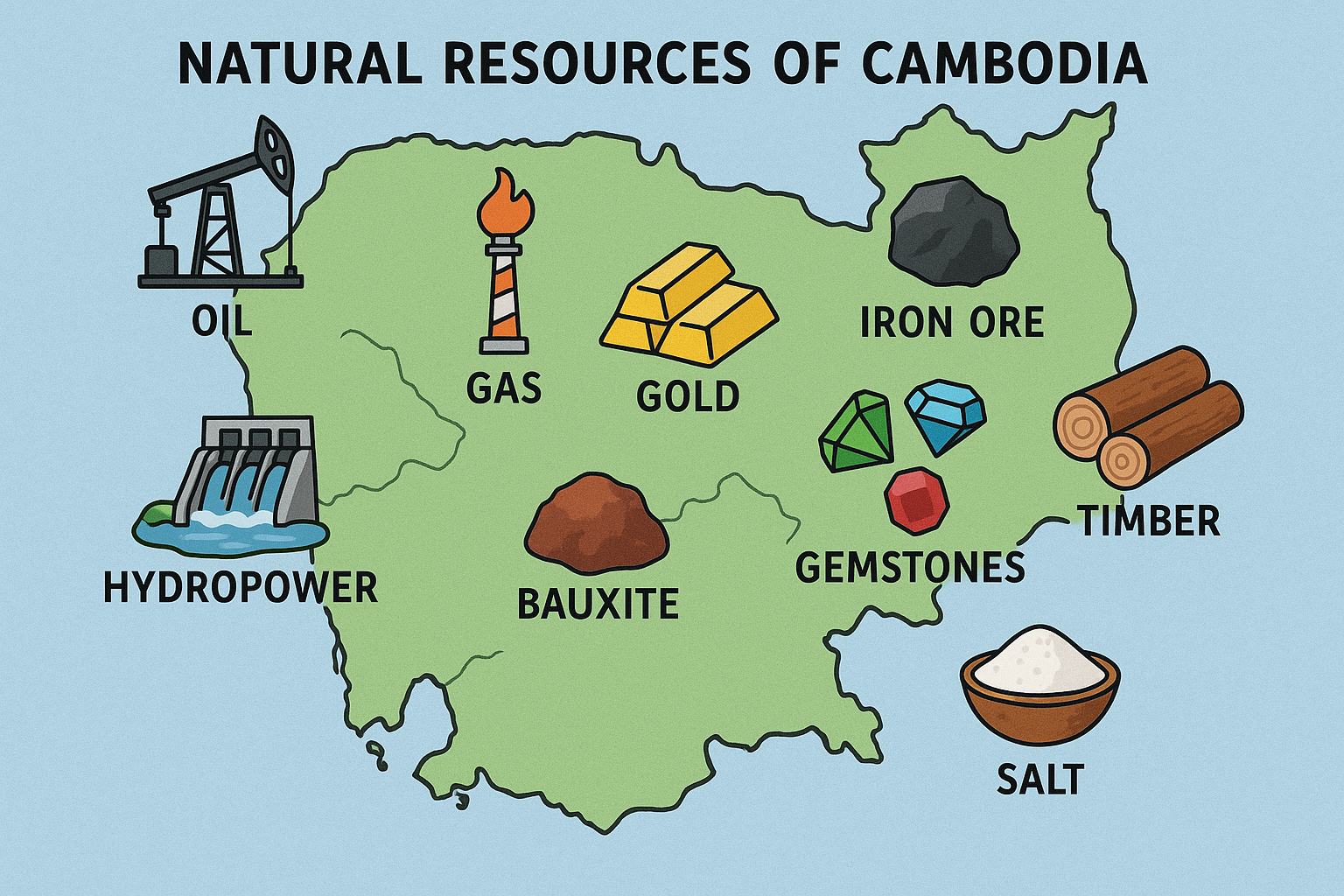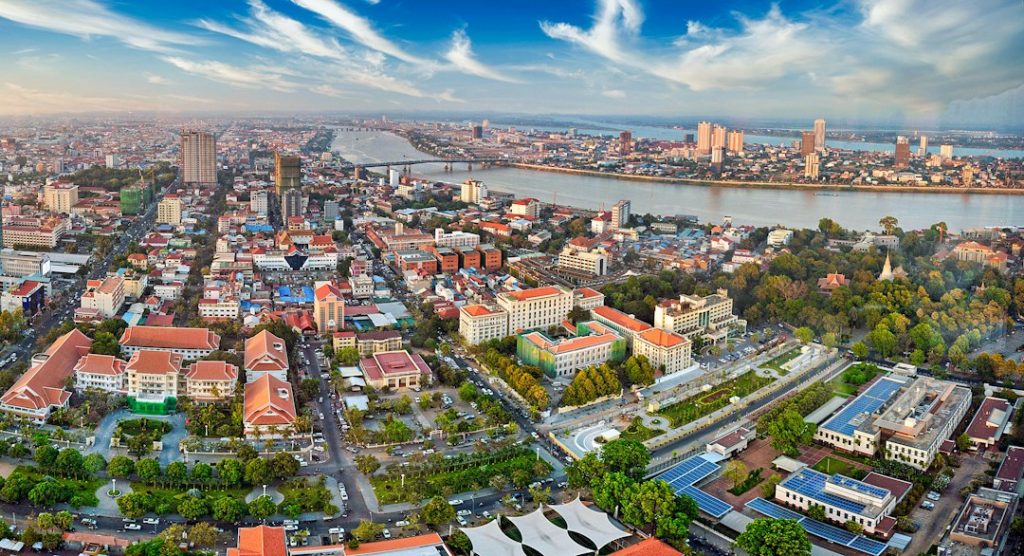Natural Resources of Cambodia: Where Natural Resources are located in Cambodia
Cambodia is a nation endowed with abundant natural resources, yet its true economic potential remains partially untapped due to challenges in natural resource governance. From the fertile banks of the Mekong River to rich forestry zones and promising offshore oil reserves, Cambodia has much to offer. This article will explore the natural resources of Cambodia, their importance to the Cambodian economy, and the policies guiding their sustainable use. Whether you’re a researcher, investor, or geography enthusiast, this deep dive offers essential insights into Cambodia’s strategic natural wealth.
Article Outline
-
What Are the Most Valuable Natural Resources in Cambodia Today?
-
How Do Cambodia’s Mineral Resources Contribute to Its Economy?
-
What Role Does the Mekong River Play in Cambodia’s Natural Resource Landscape?
-
Is Cambodia Rich in Oil and Natural Gas?
-
How Important Is Forestry and Timber to Cambodia?
-
Why Is Tonle Sap Lake Crucial to Cambodian Livelihoods and Water Resources?
-
How Does Biodiversity Fit Into Cambodia’s Ecosystem and Natural Resource Strategy?
-
What Are the Key Challenges in Cambodia’s Natural Resource Governance?
-
How Are Cambodia’s Natural Resources Tied to the Agricultural and Fishery Sectors?
-
What Is the Future of Energy in Rural Areas and Sustainable Development in Cambodia?
What Are the Most Valuable Natural Resources in Cambodia Today?
Cambodia’s landscape is rich with natural resources that span a wide spectrum—from forestry and water to mineral resources and natural gas. The country’s abundant natural resources are mainly hosted in provinces like Kampot, and areas around the Mekong basin, making them crucial for both domestic use and export potential.
Key natural resources of Cambodia include limestone, iron ore, manganese, phosphate, sand and gravel, and gemstones. These materials support industries such as mining and quarry, construction, and chemical manufacturing. Cambodia also possesses offshore oil and gas reserves in the Gulf of Thailand, attracting the attention of foreign investors and companies like Chevron.
Despite these riches, the effective utilization of resources is hindered by governance issues and limited technological infrastructure for large-scale extraction and processing.
How Do Cambodia’s Mineral Resources Contribute to Its Economy?
Cambodia’s mineral resources are still largely underexplored, though there’s considerable interest in sectors like gold, copper, and industrial minerals. The country’s mineral wealth lies primarily in areas such as Kampot province, where limestone and phosphate deposits are located. Companies like Liberty Mining International have spearheaded exploration in Cambodia.
While the mineral sector contributes only a small fraction to the country’s gross domestic product, there is increasing government interest in boosting this segment through regulatory reforms and partnerships with foreign investors.
The Cambodian government aims to develop the mining sector strategically as part of its broader development plan, though environmental concerns and land disputes remain significant obstacles.
What Role Does the Mekong River Play in Cambodia’s Natural Resource Landscape?
The Mekong River is a lifeline for Cambodia, forming the backbone of the nation’s water resources, irrigation, and fishery sectors. The river flows through Phnom Penh and supports over 80% of Cambodia’s rural population, who depend on it for agriculture and fishing.
The Mekong basin contributes immensely to soil fertility, which benefits the agricultural sector, especially rice cultivation. Additionally, the river plays a vital role in generating hydroelectric energy, thus reducing dependency on imported energy sources.
However, upstream dam development in Thailand and Laos, coupled with the impacts of climate change, poses threats to water flow and ecosystem stability. Sustainable natural resource governance is therefore essential to protect this crucial artery.
Is Cambodia Rich in Oil and Natural Gas?
Cambodia’s oil and natural gas potential remains a subject of both promise and frustration. The country’s offshore oil and gas fields in the Gulf of Thailand hold substantial oil reserves, but efforts to extract them have often stalled due to global oil prices, legal disputes, and logistical barriers.
Notably, Chevron once operated in Cambodia’s offshore Block A, but exited after failing to reach a commercial agreement with the Cambodian government. Since then, smaller firms have attempted to revive exploration and production activities, but with limited success.
Nevertheless, the sector still holds promise for reducing energy consumption costs and improving energy in rural areas, particularly if the country can attract the right kind of investment and regulatory oversight.
How Important Is Forestry and Timber to Cambodia?
Forestry remains a key component of Cambodia’s natural landscape and economy. The nation has historically enjoyed significant forest cover, although illegal logging and poor enforcement have caused deforestation at alarming rates.
High-value timber and forest products such as resin and rattan are essential to both commercial use and local communities, which often rely on firewood for cooking and heating.
However, unsustainable exploitation threatens both the biodiversity and ecosystem stability of the region. Stricter enforcement and improved natural resource governance are urgently needed to maintain environmental sustainability.
Why Is Tonle Sap Lake Crucial to Cambodian Livelihoods and Water Resources?
Tonle Sap Lake—the largest freshwater lake in Southeast Asia—is central to Cambodian life. The lake serves as a key fishery resource, supplying more than 70% of Cambodia’s protein consumption. This makes it vital for food security and livelihood in rural areas.
Seasonal flooding from the Mekong ensures the fertility of nearby lands and supports vast rice fields. The Tonle Sap ecosystem is also home to hundreds of bird and aquatic species, making it a biodiversity hotspot.
However, sedimentation, overfishing, and development pressures have endangered the Tonle Sap system. Protection of this natural gem is critical for long-term sustainable development.
How Does Biodiversity Fit Into Cambodia’s Ecosystem and Natural Resource Strategy?
Cambodia’s rich biodiversity is one of its most undervalued natural resources. Its tropical forests, mangrove swamps, and mountainous areas harbour a wide variety of flora and fauna, including several endangered species.
Preserving biodiversity isn’t just an environmental concern—it directly supports livelihood, ecosystem balance, and even tourism. Yet illegal hunting, land conversion, and climate change are putting pressure on these vital resources.
The World Bank and Asian Development Bank have been active in funding projects that support biodiversity preservation, aiming to integrate it into national natural resource governance frameworks.
What Are the Key Challenges in Cambodia’s Natural Resource Governance?
While Cambodia possesses numerous abundant natural resources, weak natural resource governance remains a major bottleneck to equitable and sustainable development. Issues include a lack of transparency, weak law enforcement, and overlapping land concessions.
The Cambodian government has attempted to improve legal frameworks and launch e-governance initiatives to enhance oversight of land and resource management, but corruption and institutional capacity continue to be concerns.
Effective governance is essential to balance economic development with environmental sustainability, especially in sensitive sectors like offshore oil, forestry, and mining.
How Are Cambodia’s Natural Resources Tied to the Agricultural and Fishery Sectors?
The agricultural sector is deeply intertwined with Cambodia’s natural endowments, relying heavily on fertile lands nourished by the Mekong River and Tonle Sap. Key crops include rice, rubber, and cassava, supported by the availability of water and forest resources.
Meanwhile, the fishery sector thrives on the country’s abundant water systems, particularly Tonle Sap Lake and the Mekong. These natural systems provide both employment and food for millions of Cambodians.
Preserving these resources is key not only for domestic consumption but also for export markets, and thus forms a critical part of Cambodia’s strategic development plans.
What Is the Future of Energy in Rural Areas and Sustainable Development in Cambodia?
As energy consumption increases, especially in growing urban areas like Phnom Penh, Cambodia must address its rural energy source challenges. Firewood remains a primary energy source in many villages, contributing to deforestation and health risks.
Investing in renewable energy, hydropower from the Mekong, and possibly offshore oil and gas could diversify the energy mix and support energy in rural areas. The Asian Development Bank and World Bank have shown interest in supporting such initiatives.
Sustainability and inclusive growth should be at the core of Cambodia’s energy policies. Balancing sustainable development with natural resource utilisation will determine the long-term success of Cambodia’s development plan.
Key Takeaways
-
Cambodia has abundant natural resources, including mineral resources, forestry, and offshore oil.
-
The Mekong River and Tonle Sap Lake are central to the country’s agricultural sector, fisheries, and energy potential.
-
Cambodia’s mineral resources—such as limestone, iron ore, and phosphate—remain underexploited but promising.
-
Forestry and firewood are important for rural energy, but need better regulation to prevent deforestation.
-
Offshore oil and natural gas exploration has seen mixed results; challenges include legal, economic, and environmental issues.
-
Natural resource governance is a key issue, with efforts underway to improve transparency and sustainability.
-
Biodiversity and ecosystems are vital for long-term environmental and economic health.
-
Energy in rural areas remains underdeveloped; switching to renewables could improve sustainable development outcomes.
-
The Cambodian economy is heavily reliant on natural resources, but diversification and better governance are necessary.
-
International institutions like the World Bank and the Asian Development Bank are supporting Cambodia’s path to balanced growth.
Forests and Timber Resources in Cambodia
Cambodia’s forests cover approximately 45% of the country’s land area and are one of its most valuable natural resources. The forests are home to a diverse range of flora and fauna, including endangered species such as tigers and elephants. They also provide important ecosystem services such as carbon sequestration and water regulation.
However, Cambodia’s forests face numerous challenges, including illegal logging, land encroachment, and unsustainable logging practices. These activities have led to deforestation and habitat loss, threatening the biodiversity and ecological balance of the country. In response to these challenges, the Cambodian government has implemented various measures to promote sustainable forestry practices, such as establishing protected areas and implementing stricter regulations on logging.
Mineral Resources in Cambodia: Gold, Copper, and More
Cambodia is also rich in mineral resources, including gold, copper, iron ore, bauxite, and gemstones. These minerals have the potential to contribute significantly to Cambodia’s economic development through mining activities. However, the management of mineral resources in Cambodia faces several challenges.
One of the main challenges is the lack of infrastructure and technical expertise needed for responsible mining practices. This has led to concerns about environmental degradation and social impacts, such as the displacement of local communities and conflicts over land rights. To address these challenges, the Cambodian government has been working to attract foreign investment and improve the regulatory framework for mining activities.
Cambodia’s Rich Agricultural Resources
Agriculture is a vital sector of Cambodia’s economy, employing a significant portion of the population and contributing to food security and rural development. The country’s agricultural resources include fertile land, water resources for irrigation, and a favorable climate for crop cultivation.
However, agricultural development in Cambodia faces several challenges, including limited access to modern farming techniques, inadequate infrastructure, and vulnerability to climate change. These challenges have hindered the sector’s productivity and competitiveness. To address these issues, the government has implemented various initiatives to promote sustainable agriculture practices, improve infrastructure, and provide support to farmers.
Water Resources in Cambodia: Rivers, Lakes, and Waterfalls
Cambodia is blessed with abundant water resources, including rivers, lakes, and waterfalls. The Mekong River, one of the longest rivers in the world, flows through Cambodia and provides a vital source of water for irrigation, transportation, and hydropower generation. The country’s lakes and waterfalls also contribute to its natural beauty and attract tourists.
However, the management of water resources in Cambodia faces challenges such as pollution, over-extraction of water for agriculture and industry, and the impacts of climate change. These challenges have implications for water quality, biodiversity, and the livelihoods of communities dependent on water resources. Efforts are being made to improve water resource management through initiatives such as watershed management plans and the promotion of sustainable water use practices.
Cambodia’s Wildlife and Biodiversity
Cambodia is home to a diverse range of wildlife and biodiversity, including endangered species such as tigers, elephants, and freshwater dolphins. The country’s forests, wetlands, and protected areas provide important habitats for these species and contribute to the overall ecological balance.
However, wildlife and biodiversity conservation in Cambodia face significant challenges, including habitat loss, illegal wildlife trade, and weak law enforcement. These challenges threaten the survival of many species and undermine the ecological integrity of the country. To address these issues, the Cambodian government has implemented various measures, such as strengthening protected area management and increasing efforts to combat wildlife trafficking.
Energy Resources in Cambodia: Hydroelectricity and Oil
Cambodia has significant energy resources, including hydropower potential and offshore oil reserves. The country has been investing in the development of hydropower projects to meet its growing energy demand and reduce reliance on imported fossil fuels. The oil sector also has the potential to contribute to Cambodia’s energy security and economic development.
However, the management of energy resources in Cambodia faces challenges such as environmental impacts, social conflicts, and concerns about transparency and governance. These challenges highlight the need for responsible energy resource management that takes into account environmental sustainability, social equity, and good governance practices.
Fisheries and Marine Resources in Cambodia
The fisheries sector is an important source of livelihoods and food security for many Cambodians. The country’s rivers, lakes, and coastal areas support a diverse range of fish species that are harvested for both domestic consumption and export.
However, fisheries and marine resource management in Cambodia face challenges such as overfishing, habitat degradation, and illegal fishing practices. These challenges threaten the sustainability of fish stocks and the livelihoods of fishing communities. Efforts are being made to address these issues through initiatives such as community-based fisheries management and the establishment of marine protected areas.
Tourism and Cultural Resources in Cambodia
Tourism is a significant contributor to Cambodia’s economy, with millions of visitors coming to explore its cultural heritage sites such as Angkor Wat and experience its natural beauty. The country’s cultural resources, including ancient temples, traditional arts, and cultural festivals, are an important part of its identity and attract tourists from around the world.
However, the management of tourism and cultural resources in Cambodia faces challenges such as overcrowding, inadequate infrastructure, and the need for sustainable tourism practices. These challenges require careful planning and management to ensure the preservation of cultural heritage sites and the sustainable development of the tourism sector.
Challenges Facing Cambodia’s Natural Resources Management
In conclusion, Cambodia’s natural resources play a crucial role in its economy and the well-being of its people. However, the management of these resources faces numerous challenges that threaten their sustainability and the country’s long-term development.
These challenges include illegal logging, unsustainable mining practices, climate change impacts on agriculture and water resources, habitat loss and wildlife trafficking, environmental impacts of energy development, overfishing and habitat degradation in fisheries, and overcrowding and inadequate infrastructure in tourism.
Addressing these challenges requires a multi-faceted approach that includes strengthening regulations and law enforcement, promoting sustainable practices, improving infrastructure and technical capacity, enhancing community participation and empowerment, and fostering international cooperation.
By addressing these challenges and promoting responsible natural resource management, Cambodia can ensure the sustainable development of its economy while preserving its natural heritage for future generations. It is crucial for all stakeholders – including the government, private sector, civil society organisations, and local communities – to work together towards this goal. Only through collective action can Cambodia’s natural resources be protected and managed in a way that benefits both the present and future generations.
FAQs
What are the natural resources of Cambodia?
Cambodia’s natural resources include timber, gemstones, iron ore, manganese, phosphates, hydropower potential, and arable land.
Where are the timber resources located in Cambodia?
The timber resources of Cambodia are located in the northern and eastern regions of the country, particularly in the provinces of Ratanakiri, Mondulkiri, and Stung Treng.
Where are the gemstone resources located in Cambodia?
The gemstone resources of Cambodia are located in the western and northern regions of the country, particularly in the provinces of Battambang, Pailin, and Siem Reap.
Where are the iron ore resources located in Cambodia?
The iron ore resources of Cambodia are located in the northern region of the country, particularly in the provinces of Preah Vihear and Stung Treng.
Where are the manganese resources located in Cambodia?
The manganese resources of Cambodia are located in the southern region of the country, particularly in the provinces of Kampot and Kep.
Where are the phosphate resources located in Cambodia?
The phosphate resources of Cambodia are located in the central and southern regions of the country, particularly in the provinces of Kampong Speu, Takeo, and Kandal.
Where is the hydropower potential located in Cambodia?
The hydropower potential of Cambodia is located in the northern and eastern regions of the country, particularly along the Mekong River and its tributaries.
Where is the arable land located in Cambodia?
The arable land of Cambodia is located throughout the country, particularly in the central and southern regions, where the fertile Mekong Delta is located.



